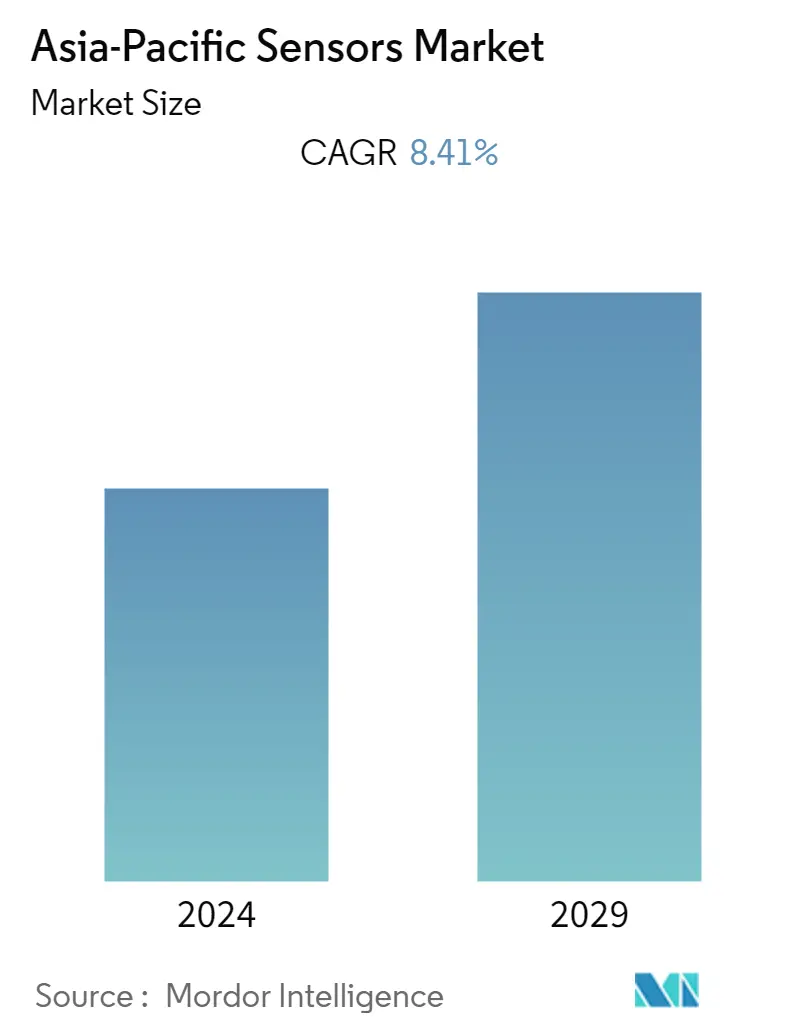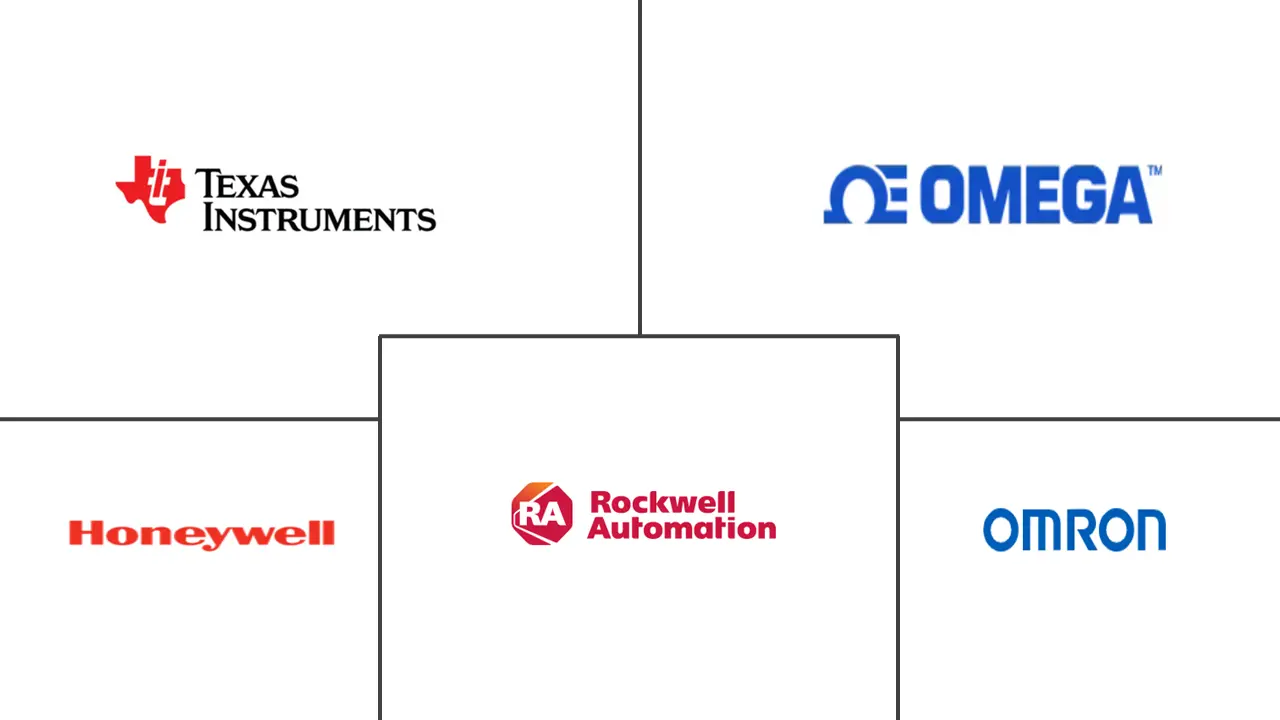Market Size of Asia-Pacific Sensors Industry

| Study Period | 2019 - 2029 |
| Base Year For Estimation | 2023 |
| Forecast Data Period | 2024 - 2029 |
| Historical Data Period | 2019 - 2022 |
| CAGR | 8.41 % |
| Market Concentration | Low |
Major Players
*Disclaimer: Major Players sorted in no particular order |
Asia-Pacific Sensors Market Analysis
The Asia-Pacific sensors market was valued at USD 47.84 billion in the current year and is expected to reach USD 75.90 billion by the end of the forecast period, registering a CAGR of 8.41% during the forecast period. Sensors are part of a broader system that gathers information about the outside environment, puts it in a comprehensible form, and then conveys it.
- Most sensors are produced in the APAC region, and sensor technology is extensively utilized worldwide since so many cutting-edge technologies depend on the functionality of the sensors. Electric grids, smart homes, and smartphones are just a few of its applications. In contrast to mature regions like North America, the APAC region is still developing and expanding its use of sensors due to the trend of smart devices, a smart environment, industry 4.0, and the Internet of Things.
- Due to the presence of significant consumer electronics manufacturers in this region, analysts predict that Asia-Pacific will dominate the sensors market. The market is anticipated to be driven by increasing smartphone penetration, 5G penetration, and advancements across numerous end-user industries. China, South Korea, Japan, and India, among others, are major Asia-Pacific countries.
- Moreover, the promise of smart cities has captivated the APAC region's technology industry. As per the recent report by Equinix, "Smart Cities: Shifting Asia", UBS projects that APAC will account for 40% of the global addressable market growth for smart city projects, or USD 800 billion by 2025. This rapid urbanization is driving IT buildout and interconnection bandwidth growth to sustain APAC's expanding digital market. As a result, smart city applications like smart grids and buildings, air and water monitoring, smart transportation, smart waste collection, and disaster response are likely to expand the opportunity areas for the sensor market.
- Although the integration of sensors increases the level of industrial automation, it incurs an additional cost, which limits its use in cost-sensitive applications. In addition, the high development costs involved in the research and development activities to manufacture new products act as a critical challenge, mainly for the cash-deficient small and medium-sized sensor manufacturers.
- The COVID-19 epidemic severely impacted the worldwide supply chain and demand for many items, making it challenging to obtain some resources. Additionally, several businesses experienced a supply deficit of different items in February and March 2020 as a result of the production halt in nations like China. The price of raw materials increased as a result of the supply chain disruption, which had an effect on the total pricing of the sensors because there wasn't enough supply to fulfill demand.
Asia-Pacific Sensors Industry Segmentation
A sensor is an instrument that notices changes in the environment and reacts to an output from another system. A sensor transforms a physical phenomenon into a quantifiable analog voltage (or occasionally a digital signal), which is then displayed in a way that can be read by humans or transferred for reading or other processing. The microphone, which transforms sound energy into an electrical signal that may be amplified, transferred, recorded, and repeated, is one of the best-known sensors.
The Asia-Pacific sensors market is segmented by parameters measured (temperature, pressure, level, flow, proximity, environmental, chemical, inertial, magnetic, vibration), by mode of operation (optical, electrical resistance, biosensors, piezoresistive, image, capacitive, piezoelectric, lidar, radar), by end-user industry (automotive, consumer electronics (smartphones, tablets, laptops, and computers), wearable devices, smart appliances or devices), energy, industrial and other, medical and wellness, construction, agriculture, mining, aerospace, and defense), and by country. The market sizes and forecasts are provided in terms of value in USD billion for all the above segments.
| By Parameters Measured | |
| Temperature | |
| Pressure | |
| Level | |
| Flow | |
| Proximity | |
| Environmental | |
| Chemical | |
| Inertial | |
| Magnetic | |
| Vibration | |
| Other Parameters Measured |
| By Mode of Operation | |
| Optical | |
| Electrical Resistance | |
| Biosensors | |
| Piezoresistive | |
| Image | |
| Capacitive | |
| Piezoelectric | |
| Lidar | |
| Radar | |
| Other Modes of Operation |
| By End-User Industry | |||||||
| Automotive | |||||||
| |||||||
| Energy | |||||||
| Industrial And Other | |||||||
| Medical And Wellness | |||||||
| Construction, Agriculture, And Mining | |||||||
| Aerospace | |||||||
| Defense |
| By Country | |
| China | |
| India | |
| Japan | |
| Rest of APAC |
Asia-Pacific Sensors Market Size Summary
The Asia-Pacific sensors market is experiencing significant growth, driven by the region's robust manufacturing capabilities and the increasing adoption of smart technologies. As a hub for consumer electronics, the APAC region benefits from the presence of major manufacturers, particularly in countries like China, South Korea, Japan, and India. The market is expanding due to the rising penetration of smartphones and the rollout of 5G technology, which are heavily reliant on advanced sensor applications. The trend towards smart cities further propels market growth, with sensors playing a crucial role in smart grids, transportation, and environmental monitoring. Despite challenges such as high development costs and the impact of the COVID-19 pandemic on supply chains, the market continues to thrive, supported by innovations in sensor technology and increasing demand across various end-user industries.
The competitive landscape of the Asia-Pacific sensors market is characterized by the presence of key players like Texas Instruments, Omron, and Honeywell, who are actively investing in research and development to enhance their product offerings. The market is fragmented, with companies striving to maintain a competitive edge through technological advancements. Notably, China has emerged as a leader in the image sensor market, driven by its expanding economy and significant contributions to the global electronics industry. The automotive sector also plays a pivotal role in sensor demand, particularly in China, where a large volume of vehicles is produced annually. As the market continues to evolve, initiatives such as sensor-based smart agriculture projects in India highlight the growing integration of sensors with IoT and automation technologies, further underscoring the market's potential for growth in the coming years.
Asia-Pacific Sensors Market Size - Table of Contents
-
1. MARKET INSIGHTS
-
1.1 Market Overview
-
1.2 Industry Attractiveness - Porter's Five Forces Analysis
-
1.2.1 Bargaining Power of Suppliers
-
1.2.2 Bargaining Power of Buyers
-
1.2.3 Threat of New Entrants
-
1.2.4 Threat of Substitutes
-
1.2.5 Degree of Competition
-
-
1.3 Industry Value Chain/Supply Chain Analysis
-
1.4 Macroeconomic Factors Affecting the Industry
-
-
2. MARKET SEGMENTATION
-
2.1 By Parameters Measured
-
2.1.1 Temperature
-
2.1.2 Pressure
-
2.1.3 Level
-
2.1.4 Flow
-
2.1.5 Proximity
-
2.1.6 Environmental
-
2.1.7 Chemical
-
2.1.8 Inertial
-
2.1.9 Magnetic
-
2.1.10 Vibration
-
2.1.11 Other Parameters Measured
-
-
2.2 By Mode of Operation
-
2.2.1 Optical
-
2.2.2 Electrical Resistance
-
2.2.3 Biosensors
-
2.2.4 Piezoresistive
-
2.2.5 Image
-
2.2.6 Capacitive
-
2.2.7 Piezoelectric
-
2.2.8 Lidar
-
2.2.9 Radar
-
2.2.10 Other Modes of Operation
-
-
2.3 By End-User Industry
-
2.3.1 Automotive
-
2.3.2 Consumer Electronics
-
2.3.2.1 Smartphones
-
2.3.2.2 Tablets, Laptops, and Computers
-
2.3.2.3 Wearable Devices
-
2.3.2.4 Smart Appliances or Devices
-
2.3.2.5 Other Consumer Electronics
-
-
2.3.3 Energy
-
2.3.4 Industrial And Other
-
2.3.5 Medical And Wellness
-
2.3.6 Construction, Agriculture, And Mining
-
2.3.7 Aerospace
-
2.3.8 Defense
-
-
2.4 By Country
-
2.4.1 China
-
2.4.2 India
-
2.4.3 Japan
-
2.4.4 Rest of APAC
-
-
Asia-Pacific Sensors Market Size FAQs
What is the current Asia-Pacific Sensors Market size?
The Asia-Pacific Sensors Market is projected to register a CAGR of 8.41% during the forecast period (2024-2029)
Who are the key players in Asia-Pacific Sensors Market?
Texas Instruments Incorporated, Omega Engineering Inc., Honeywell International Inc., Rockwell Automation Inc. and Omron Corporation are the major companies operating in the Asia-Pacific Sensors Market.

